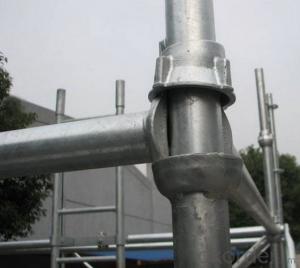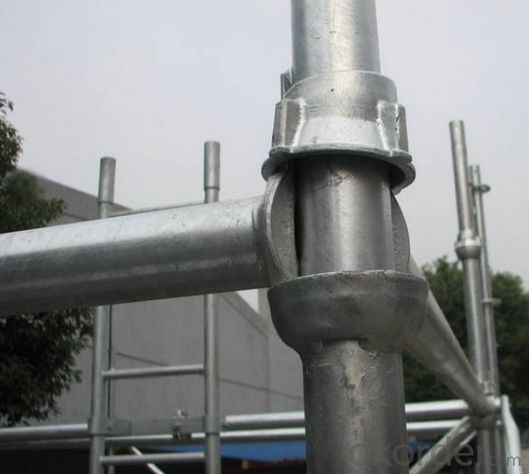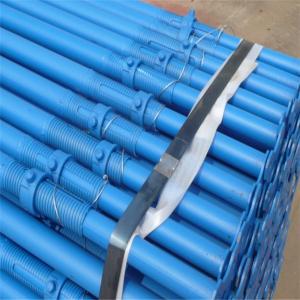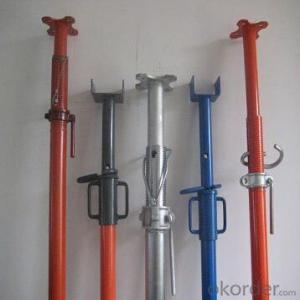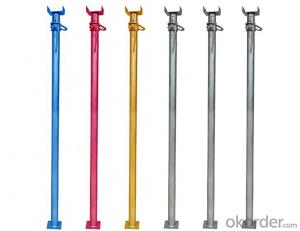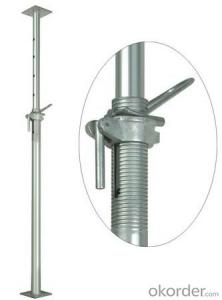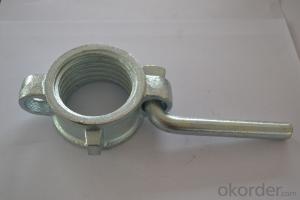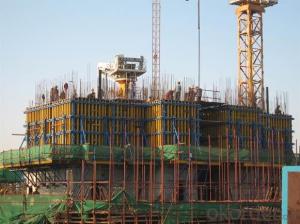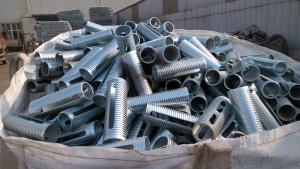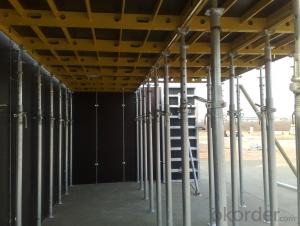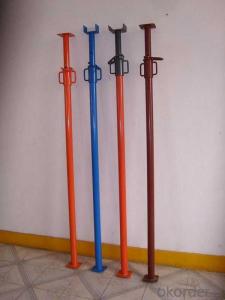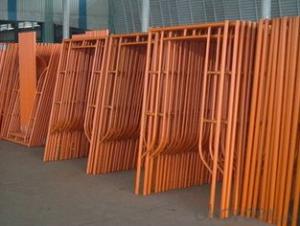Best Price Used Layher Scaffolding,Scaffolding Parts,Scaffolding Pipe Parts
- Loading Port:
- China Main Port
- Payment Terms:
- TT OR LC
- Min Order Qty:
- -
- Supply Capability:
- -
OKorder Service Pledge
OKorder Financial Service
You Might Also Like
Quick Details
| Minimum Order Quantity: | Material: |
| Model Number: | Surface Treatment: | ||||
| FOB Price: | Delivery Time: | Packing Details: |
Packaging & Delivery
| Packaging Detail: | Packed in woven bags or pallet. 25pieces one bag. |
| Delivery Detail: | Within 30days after receiving your advance payment or L/C |
Specifications
1.Material: Q195, Q235, etc
2.Advantage: easy combination, safety, stable
3.Surface: Pre galvanized
Specifications of the Product
1)size: 48.3mm
2) Min.Slip Load:10.5Mpa
3) Distortion Load:18KN
4) Weight: 0.5--1.5kg
5) superficial treatment: hot dip galvanized; galvanized
6) Material:Q235,Q195etc
7) Size for tube:45mm 47.5mm 48.3mm 50mm
8) Production technology: Drop forged
9) Surface treatment: Dipping paint, Zinc plated, Galvanized.
10) Color: Red, Self color, Gold color, Silver color or as per customized.
11) Application: Connect tow scaffolding pipe for arbitrary angle( Swivel)
12) Quality: Excellent Anti-Broken/ Anti-Slipping/Anti-Resisting/ Anti-Rusting/Easily Installing
13) Standard:EN74/BS1139 swivel coupler
- Q: Are steel props suitable for use in high-voltage transmission line construction?
- Steel props are not suitable for use in high-voltage transmission line construction. These props are typically used in construction activities to provide temporary support to structures. However, in the case of high-voltage transmission line construction, there are several reasons why steel props are not suitable. Firstly, high-voltage transmission lines carry extremely high electrical currents. Steel is a good conductor of electricity, which means that using steel props near these lines can increase the risk of electrical accidents. If the props come into contact with the transmission lines, it can result in electricity conducting through them, posing a significant danger to workers and potentially causing equipment damage. Secondly, steel props may not have the necessary insulation properties required for high-voltage environments. High-voltage transmission lines often operate at voltages ranging from 69,000 volts to over 500,000 volts. It is crucial to ensure that any equipment used in their construction is properly insulated to prevent electrical discharge or arcing between the props and the transmission lines. Additionally, steel props may not have the structural strength and stability required for high-voltage transmission line construction. These lines often span over long distances and are subjected to various environmental factors such as wind, ice, and temperature changes. The props used in their construction need to be able to withstand these forces and maintain their stability, which may not be guaranteed with steel props. Instead, specialized equipment and tools designed specifically for high-voltage transmission line construction are used. These include insulated aerial lifts, conductive ropes, and other safety gear that are engineered to meet the unique requirements and safety standards of working near high-voltage infrastructure. In conclusion, steel props are not suitable for use in high-voltage transmission line construction due to their conductive nature, lack of insulation properties, and potential structural limitations. It is crucial to prioritize safety and use specialized equipment that is specifically designed for working in high-voltage environments to minimize risks and ensure the successful completion of these projects.
- Q: How do you store steel props?
- Steel props can be stored by disassembling them and laying the individual components flat on a pallet or rack. It is important to ensure that the props are clean and free from any moisture before storing them to prevent rusting. Additionally, labeling each component and keeping an inventory can help in efficiently accessing and using the props when needed.
- Q: What are the different sizes and lengths of steel props available?
- Steel props, also known as adjustable steel support props or adjustable steel shoring props, come in various sizes and lengths to cater to different construction needs. These props are commonly used in construction projects to support temporary structures like formwork, scaffolding, and falsework. The sizes and lengths of steel props can vary depending on the manufacturer and the specific requirements of the project. However, some common sizes and lengths are widely available in the market. Sizes: 1. Size 0: This is the smallest size available and is commonly used for lighter loads and applications. It typically has an adjustable range from approximately 1.04 meters to 1.83 meters. 2. Size 1: This is a popular size for general construction purposes and is suitable for medium loads. The adjustable range for size 1 props is typically between 1.75 meters and 3.12 meters. 3. Size 2: This size is often used for heavier loads and larger construction projects. The adjustable range for size 2 props is usually between 1.98 meters and 3.35 meters. 4. Size 3: Size 3 props are designed for heavy-duty applications and can support significant loads. The adjustable range for size 3 props typically extends from 2.59 meters to 4.01 meters. Lengths: In addition to the different sizes, steel props also come in various lengths to provide flexibility in construction projects. The lengths available can range from a few meters up to several meters, depending on the manufacturer and the specific requirements of the project. It is important to note that these sizes and lengths mentioned above are just common examples, and there may be variations based on the manufacturer and specific project needs. It is always recommended to consult with a professional engineer or supplier to determine the appropriate size and length of steel props required for a particular construction project.
- Q: Can steel props be used in the construction of schools?
- Yes, steel props can be used in the construction of schools. Steel props are commonly used to support temporary structures during construction, including scaffolding, formwork, and falsework. They provide stability and strength to ensure the safety of the construction site and workers. In the case of school construction, steel props can be used to support various elements such as beams, columns, and floors, ensuring the structural integrity of the building.
- Q: What are the design considerations for using steel props?
- Several important factors must be taken into account when considering the use of steel props in a design. These factors include load capacity, adjustability, stability, safety, and ease of installation and removal. Load capacity is one of the primary design considerations for steel props. The props must have the ability to support the weight of the structure or load they are intended to support. This requires careful calculation and evaluation of expected load, considering variables such as structure type, materials used, and additional forces or stresses on the props. Another crucial consideration is adjustability. Steel props should be easily adjustable to accommodate different heights and provide flexibility during construction or renovation projects. The ability to extend or retract the props allows for precise positioning and support, ensuring stability and accuracy in the construction process. Stability is critical when using steel props, as they must provide a secure and stable support system. The design should incorporate features such as a wide base or additional bracing to prevent potential movement or collapse. This is especially important when the props are supporting heavy loads or are subject to external forces like wind or vibrations. Safety is a paramount consideration in any design involving steel props. The design should prioritize the safety of workers and others on the construction site by minimizing the risk of accidents or injuries. This may involve incorporating safety features like non-slip surfaces, secure locking mechanisms, or visual indicators to ensure proper installation and usage. Lastly, ease of installation and removal is an important consideration to facilitate efficient and cost-effective construction processes. The design should allow for quick and easy assembly and disassembly of the props, reducing labor and time requirements. This can be achieved through features like lightweight materials, user-friendly mechanisms, and intuitive instructions. In conclusion, when designing with steel props, it is crucial to consider factors such as load capacity, adjustability, stability, safety, and ease of installation and removal. By carefully addressing these considerations, engineers and designers can ensure the effective and safe use of steel props in construction projects.
- Q: What are the different connection methods available for steel props?
- There are several different connection methods available for steel props, depending on the specific requirements and applications. Some of the commonly used connection methods include: 1. Pin Connection: In this method, steel props are connected using pins or bolts. This allows for easy adjustment of the length of the props and provides stability and strength to the structure. Pin connections are often used in temporary structures or scaffolding systems. 2. Welded Connection: Welding is another common method used for connecting steel props. It involves permanently joining the props together by melting and fusing the metal at the connection points. Welded connections provide high strength and rigidity, making them suitable for long-term or permanent structures. 3. Sleeve Connection: A sleeve connection involves using a steel sleeve that is slipped over the ends of the props and secured with bolts or pins. This method provides a secure and adjustable connection, allowing for easy length adjustment of the props. 4. Adjustable Coupling Connection: This type of connection uses adjustable couplings that are threaded onto the ends of the props. The couplings can be tightened or loosened to adjust the length of the props as needed. This connection method is often used in construction projects where frequent adjustments are required. 5. Hydraulic Connection: Hydraulic connections involve using hydraulic cylinders or jacks to connect and adjust the length of the props. This method offers precise control over the length adjustment and is commonly used in heavy-duty applications or in situations where a high load capacity is required. Overall, the choice of connection method for steel props depends on factors such as the specific application, load requirements, adjustability needs, and the desired strength and stability of the structure. It is important to choose the appropriate connection method to ensure the safety and efficiency of the construction project.
- Q: Are steel props suitable for supporting temporary stages for concerts?
- Yes, steel props are suitable for supporting temporary stages for concerts. Steel props are strong, durable, and can provide the necessary stability and support required for a temporary stage setup. They can bear the weight of heavy equipment, lighting rigs, and performers, ensuring a safe and secure platform for concerts.
- Q: Are steel props resistant to ultraviolet (UV) radiation?
- No, steel props are not resistant to ultraviolet (UV) radiation.
- Q: Can steel props be used for shoring or formwork support?
- Indeed, shoring or formwork support can be achieved using steel props. These props, also recognized as adjustable props or acrow props, are extensively employed in construction to offer temporary support to structures or formwork throughout the construction phase. Constructed primarily of steel, they possess an adjustable height characteristic that allows for extension or retraction to the desired length. The versatility of steel props permits their usage in various shoring or formwork applications. They are frequently employed to sustain horizontal or vertical loads, such as slabs, beams, or walls, during construction or renovation undertakings. Additionally, they can temporarily support formwork systems, guaranteeing proper alignment and stability throughout the concrete pouring and curing stages. The adjustability feature of steel props renders them suitable for diverse construction scenarios, as they can be effortlessly modified to the necessary height and securely positioned. This adaptability enables efficient installation and removal, reducing downtime and optimizing productivity at the construction site. Moreover, steel props are renowned for their robustness and longevity due to their high-quality steel composition. This ensures their capability to withstand the substantial loads and forces encountered during construction activities. Designed to provide dependable support and stability, they enhance the safety and integrity of the structure or formwork system. In conclusion, steel props are indisputably appropriate for shoring or formwork support. Their adjustable height feature, strength, and durability make them an ideal selection for delivering temporary support and stability to structures or formwork systems during the construction process.
- Q: Do steel props have any safety instructions or guidelines for use?
- Yes, steel props typically come with safety instructions and guidelines for their use. These instructions may include recommendations on weight limits, proper positioning and placement, securing methods, and maintenance procedures to ensure safe and effective use of the props. It is important to follow these guidelines to prevent accidents, injuries, and damage to structures.
Send your message to us
Best Price Used Layher Scaffolding,Scaffolding Parts,Scaffolding Pipe Parts
- Loading Port:
- China Main Port
- Payment Terms:
- TT OR LC
- Min Order Qty:
- -
- Supply Capability:
- -
OKorder Service Pledge
OKorder Financial Service
Similar products
Hot products
Hot Searches
Related keywords
